![]()
![]()
![]()
Use LEFT and RIGHT arrow keys to navigate between flashcards;
Use UP and DOWN arrow keys to flip the card;
H to show hint;
A reads text to speech;
25 Cards in this Set
- Front
- Back

|
lesion at the premotor neuron to the lower motor neuron so whne asked to smile she cant BUT if told a funny joke she smiles due to the effects of the medial emotional systems
|
|
|
2 types of motor Systems
|
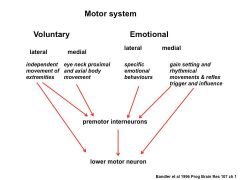
emotional aspects built into the motor systems (e.g aggressive walk or smooth...)
|
|
|
How do conscious & unconscious perceptions produce visceral & skeletomotor & cognitive response?
|

|
|
|
How do Visceral sensations & perception interact?
|
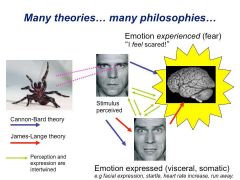
patterned (sterotypical) behaviour
- prepares for required behaviour: HR, gut motility, sweating... - COMMUNICATES emotion; skeletomotor, facial expression, body postural... |
|
|
How do neural circuits of emotion give rise to conscious perception?
|
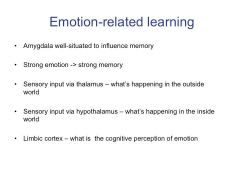
|
|
|
Concious perception results from
|
1. sensory input
2. visceral input 3. prior learning |
|
|
The limbic system
|

|
|
|
Anatomy of the limbic System
|
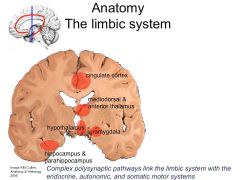
Hypothalamus: major controller of ANS
Amygdala: fear & loathing, influences memory Thalamus: sensory relay, attention, memory Cortex: getting attention, assessing significance, suppressing or activating behaviour - anterior cingulate - orbital prefrontal - central prefrontal - insula cortex |
|
|
Hypothalamus
|
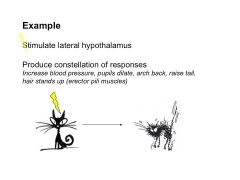
- coordinates peripheral motor expression
eg; BP, temp, energy, reproduction INPUTS: - BRF, visceral sensation, retina, olfactory bulb, hippocampus, amygdala, cortex RESPONSE: - ant & post pituitary, thalamus, amygdala, ANS control centres RSS and PAG RSS: reticulospinal system; motor coordinates stereotypic defencive reactions, reflexes eg startle PAG: mediates motor behaviour, with inputs also from amygdala and visceral centres |
|
|
Amygdala
|
- integrates and mediates between sensory inputs, hypothalamus & cognitive centres (cortex)
- several nuclei - 3 basolateral groups - corticomedial - central |
|
|
Amygdala INS and OUTS
|
INS:
- massive sensory: thalamus and cortex and DIRECT olfactory (MAGNIFIES sensory stimuli) - visceral sensory: central nucleus of hypothalamus, PAG and parabrachial n. (MAGNIFIES) - cortical: OF, AC, Insula = hippocoampus: links emotion related aspects of memory OUTPUTS: UP: to limbic cortex; influences emotional perception, sensory heighten attention DOWN: (hypothalamus, BS ANS centres, PAG, striatum) motor plans, habits, motivation |
|
|
Amygdalar groups
|
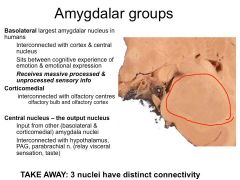
|
|
|
Amygdalar Lesion
|
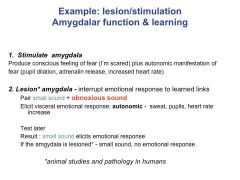
|
|
|
Central n. amygdala outputs
|
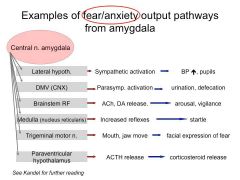
|
|
|
Bilateral Amygdalar Lesions
|
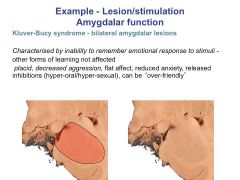
|
|
|
Amygdala and recognition of emotional signals
|

- amydala INC. activation with fear/anger in others (reading facial expressions)
- sympathetic activation: (eg amphetamines) INC. emotional salience to facial expression (scarier) |
|
|
Facial Scanning
|
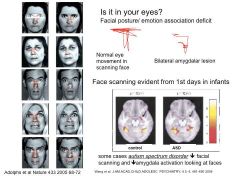
|
|
|
Limbic Cortex anatomy
|

- OF: eyeball depressions
|
|
|
Anterior Cingulate Cortex
|
ventral: affective
dorsal: cognitive - connections between Amg, PAG, ANS regions BR, An. Thalamic VISCERAL PREMOTOR region: activates vicers (GI, HR) - Activated during emotional charged tasks (happy, sad..) - Empathy? reposnds to visions of pain in others - Cognitive area: active during attention demanding tasks & error monitoring - excessive activity: depression.. or can be dec. BUT JUST REMEMBER THAT CHANGE IN ACTIVITY FOR AFFECTIVE DISORDERS - lesions: reduced self awareness, motor and cogn. flatness, muteness, reduced appreciation of pain, no emotional response to emotive stimuli |
|
|
Romantic Love
|
ACC activated in deep romantic love (also activated in depression...lol)
INC. insula activity |
|
|
Insular Cortex
|

taste and emotion
- disgust and contempt FN: visceral sens., taste, pain OUTPUT: Amg, lateral hypothalamus Also the touchy feely cortex: respond to pleasant touch and imagining romantic and maternal love |
|
|
Insular Lesion
|
- Impair recognition of disgust in facial expression and in ability to experience disgust
|
|
|
Orbital prefrontal cortex
|
- decision making relative to emotional state
- ice pick surgeries preformed here - decision making relative to social situation - processes aversive emotions - recognition of emotion from voice and facial expression - INC. activity OFC in facial expression of fear/anger |
|
|
Damage to Orbitofrontal areas
|
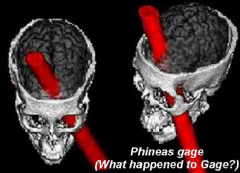
- impaired decision making abilities (requiring feedback form social or emotional cues)
- lack of ability to evaluate social context and to determine if the action is appropriate (eg gambling) - utlization behviour: pick up objects and use even if asked not to - abnormal imitative behavior - can lack ability to monitor and control aggressive impulse and risk taking - frontotemporal dementia - PHINEAS GAGE |
|
|
Ventral Prefrontal Cortex
|
INC. activity; happy
DEC. activity: sad Lesions: Left = depressed right = mania (rare) Orbio and ventral prefrontal cortex: impulse inhibitors, active when trying to control emotions |

